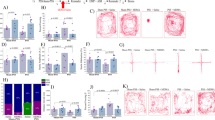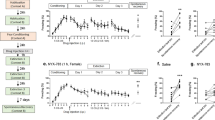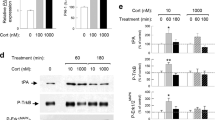Abstract
A cardinal feature of post-traumatic stress disorder (PTSD) is a long-lasting paradoxical alteration of memory with hypermnesia for salient traumatic cues and amnesia for peri-traumatic contextual cues. So far, pharmacological therapeutic approach of this stress-related disorder is poorly developed mainly because of the lack of animal model for this paradoxical memory alteration. Using a model that precisely recapitulates the two memory components of PTSD in mice, we tested if brexpiprazole, a new antipsychotic drug with pro-cognitive effects in rodents, may persistently prevent the expression of PTSD-like memory induced by injection of corticosterone immediately after fear conditioning. Acute administration of brexpiprazole (0.3 mg/kg) 7 days’ post-trauma first blocks the expression of the maladaptive fear memory for a salient but irrelevant trauma-related cue. In addition, it enhances (with superior efficacy when compared to diazepam, prazosin, and escitalopram) memory for the traumatic context, correct predictor of the threat. This beneficial effect of brexpiprazole is overall maintained 1 week after treatment. In contrast brexpiprazole fully spares normal/adaptive cued fear memory, showing that the effect of this drug is specific to an abnormal/maladaptive (PTSD-like) fear memory of a salient cue. Finally, this treatment not only promotes the switch from PTSD-like to normal fear memory, but also normalizes most of the alterations in the hippocampal–amygdalar network activation associated with PTSD-like memory, as measured by C-Fos expression. Altogether, these preclinical data indicate that brexpiprazole could represent a new pharmacological treatment of PTSD promoting the normalization of traumatic memory.
This is a preview of subscription content, access via your institution
Access options
Subscribe to this journal
Receive 12 print issues and online access
$259.00 per year
only $21.58 per issue
Buy this article
- Purchase on Springer Link
- Instant access to full article PDF
Prices may be subject to local taxes which are calculated during checkout





Similar content being viewed by others
References
American Psychiatric Association. Diagnostic and statistical manual of mental disorders. 4th ed. Washington, DC: American Psychiatric Publishing; 2000.
American Psychiatric Association. Diagnostic and statistical manual of mental disorders, 5th ed. Washington, DC: American Psychiatric Publishing; 2013.
Janet P. L’automatisme psychologique. Paris: Felix Alcan; 1889.
Breuer J, Freud S. On the psychical mechanism of histerical phenomena: preliminary communication. In: Strachy J, editor and Trans. The standard edition of the complete psychological works of Sigmund Freud, Vol 2. London: Hogarth Press; 1893. pp 3–17.
Myers CS. A contribution to the study of the shell-Shock. Lancet. 1915;185:316–20.
van der Kolk BA. Psychological trauma, Washington, DC: American Psychiatric Press; 1987.
van der Kolk BA. The body keeps the score: memory and the evolving psychobiology of posttraumatic stress. Harv Rev Psychiatry. 1994;1:253–65.
van der Kolk BA, Hooper JW, Osterman JE. Exploring the nature of traumatic memory: combining clinical knowledge with laboratory methods. J Aggress Maltreat Trauma. 2001;4:9–32.
Brewin CR, Holmes EA. Psychological theories of posttraumatic disorder. Clin Psychol Rev. 2003;23:339–76.
Brewin CR. What is it that a neurobiological model of PTSD must explain? Prog Brain Res. 2008;167:217–28.
Brewin CR, Dalgleish T, Joseph S. A dual representation theory of posttraumatic stress disorder. Psychol Rev. 1996;103:670–90.
Desmedt A, Marighetto A, Piazza PV. Abnormal fear memory as a model for PTSD. Biol Psychiatry. 2015a;78:290–7.
Kar N. Cognitive behavioral therapy for the treatment of post-traumatic stress disorder: a review. Neuropsychiatr Dis Treat. 2011;7:167–81.
Kaouane N, Porte Y, Vallée M, Brayda-Bruno L, Mons N, Calandreau L, et al. Glucocorticoids can induce PTSD-like memory impairments in mice. Science. 2012;335:1510–3.
Maeda K, Sugino H, Akazawa H, Amada N, Shimada J, Futamura T, et al. Brexpiprazole I: in vitro and in vivo characterization of a novel serotonin-dopamine activity modulator. J Pharmacol Exp Ther. 2014a;350:589–604.
Roth BL, Sheffler DJ, Kroeze WK. Magic shotguns versus magic bullets: selectively non-selective drugs for mood disorders and schizophrenia. Nat Rev Drug Discov. 2004;3:353–9.
Arnt J, Skarsfeldt T. Do novel antipsychotics have similar pharmacological characteristics? A review of the evidence. Neuropsychopharmacology. 2008;18:63–101.
Citrome L, Stensbøl TB, Maeda M. The preclinical profile of brexpiprazole: what is its clinical relevance for the treatment of psychiatric disorders? Expert Rev Neurother. 2015;15:1219–29.
Maeda K, Lerdrup L, Sugino H, Akazawa H, Amada N, McQuade RD, et al. Brexpiprazole II: antipsychotic-like and procognitive effects of a novel serotonin-dopamine activity modulator. J Pharmacol Exp Ther. 2014b;350:605–14.
Cohen H, Zohar J, Kaplan Z, Arnt J. Adjunctive treatment with brexpiprazole and escitalopram reduces behavioral stress responses and increase hypothalamic NPY immunoreactivity in a rat model of PTSD-like symptoms. Eur Neuropsychopharmacol. 2018;28:63–74.
Bremner JD, Vythilingam M, Vermetten E, Southwick SM, McGlashan T, Nazeer A, et al. MRI and PET study of deficits in hippocampal structure and function in women with childhood sexual abuse and posttraumatic stress disorder. Am J Psychiatry. 2003;160:924–32.
Elzinga BM, Bremner JD. Are the neural substrates of memory the final common pathway in post-traumatic stress disorder (PTSD)? J Affect Disord. 2002;70:1–17.
Nutt DJ, Malizia AL. Structural and functional brain changes in posttraumatic stress disorder. J Clin Psychiatry. 2004;65:11–17.
Shin LM, Shin PS, Heckers S, Krangel TS, Macklin ML, Orr SP, et al. Hippocampal function in posttraumatic stress disorder. Hippocampus. 2004;14:292–300.
Larsen AK, Brennum LT, Egebjerg J, Sánchez C, Halldin C, Andersen PH. Selectivity of (3)H-MADAM binding to 5-hydroxytryptamine transporters in vitro and in vivo in mice; correlation with behavioural effects. Br J Pharmacol. 2004;141:1015–23.
Olson VG, Rockett HR, Reh RK, Redila VA, Tran PM, Venkov HA, et al. The role of norepinephrine in differential response to stress in an animal model of posttraumatic stress disorder. Biol Psychiatry. 2011;70:441–8.
Patel S, Fernandez-Garcia E, Hutson PH, Patel S. An in vivo binding assay to determine central alpha(1)-adrenoceptor occupancy using [(3)H]prazosin. Brain Res Brain Res Protoc. 2001;8:191–8.
Serradeil-Le Gal C, Wagnon J 3rd, Tonnerre B, Roux R, Garcia G, Griebel G, et al. An overview of SSR149415, a selective nonpeptide vasopressin V(1b) receptor antagonist for the treatment of stress-related disorders. CNS Drug Rev. 2005;11:53–68.
Lundbeck (data on file): Unpublished mouse in vivo binding and pharmacokinetic data.
Yoshimi N, Futamura T, Hashimoto K. Improvement of dizocilpine-induced social recognition deficits in mice by brexpiprazole, a novel serotonin-dopamine activity modulator. Eur Neuropsychopharmacol. 2015;25:356–64.
Frampton JE. Brexpiprazole: a review in schizophrenia. Drugs. 2019;79:189–200.
Desmedt A, Garcia R, Jaffard R. Differential modulation of changes in hippocampal-septal synaptic excitability by the amygdala as a function of either elemental or contextual fear conditioning in mice. J Neurosci. 1998;18:480–7.
Desmedt A, Garcia R, Jaffard R. Vasopressin in the lateral septum promotes elemental conditioning to the detriment of contextual fear conditioning in mice. Eur J Neurosci. 1999;11:3913–21.
Calandreau L, Trifilieff P, Mons N, Costes L, Marien M, Marighetto A, et al. Extracellular hippocampal acetylcholine level controls amygdala function and promotes adaptive conditioned emotional response. J Neurosci. 2006;26:13556–66.
Calandreau L, Desgranges B, Jaffard R, Desmedt A. Switching from contextual to tone fear conditioning and vice versa: the key role of the glutamatergic hippocampal-lateral septal neurotransmission. Learn Mem. 2010;17:440–3.
Dudai Y. The neurobiology of consolidations, or, how stable is the engram? Annu Rev Psychol. 2004;55:51–86.
Nader K, Schafe GE, LeDoux JE. The labile nature of consolidation theory. Nat Rev Neurosci. 2000;1:216–9.
Nader K. Neuroscience: re-recording human memories. Nature. 2003;425:571–2.
Sara SJ. Strengthening the shaky trace through retrieval. Nat Rev Neurosci. 2000;1:212–3.
Brewin CR. The nature and significance of memory disturbance in posttraumatic stress disorder. Annu Rev Clin Psychol. 2011;7:203–27.
Bouton ME. Context and behavioral processes in extinction. Learn Mem 2004;11:485–94.
Layton B, Krikorian R. Memory mechanisms in posttraumatic stress disorder. J Neuropsy Clin Neurosci. 2002;14:254–61.
LeDoux JE. Emotion circuits in the brain. Annu Rev Neurosci. 2000;23:155–84.
Yaniv D, Desmedt A, Jaffard R, Richter-Levin G. The amygdala and appraisal processes: stimulus and response complexity as an organizing factor. Brain Res Rev. 2004;44:179–86.
Desmedt A, Marighetto A, Richter-Levin G, Calandreau L. Adaptive emotional memory: the key hippocampal-amygdalar interaction. Stress. 2015;11:1–12.
Acknowledgements
We thank all of the personnel of the Animal Facility of the Neurocentre Magendie for mouse care. This work was supported by H Lundbeck A/S, Institut National de la Santé et de la Recherche Médicale, Centre National de la Recherche Scientifique, Conseil Régional d’Aquitaine, Ministère de l’Enseignement supérieur et de la Recherche, University of Bordeaux.
Author information
Authors and Affiliations
Corresponding author
Ethics declarations
Conflict of interest
The authors declare no competing financial interests. CM is a Lundbeck employee and JA is a paid consultant for Lundbeck.
Additional information
Publisher’s note Springer Nature remains neutral with regard to jurisdictional claims in published maps and institutional affiliations.
Supplementary information
Rights and permissions
About this article
Cite this article
Ducourneau, EG., Guette, C., Perrot, D. et al. Brexpiprazole blocks post-traumatic stress disorder-like memory while promoting normal fear memory. Mol Psychiatry 26, 3018–3033 (2021). https://doi.org/10.1038/s41380-020-0852-z
Received:
Revised:
Accepted:
Published:
Issue Date:
DOI: https://doi.org/10.1038/s41380-020-0852-z



